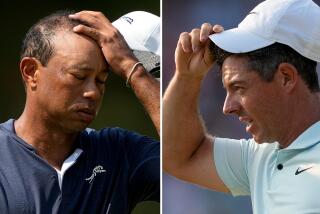THE YEAR OF THE OLD SPORT : Wendy Turnbull, Tom Gullikson Are Exceptions in Sport Where 30 Is Old
- Share via
It has been almost 50 years since Bobby Riggs dazzled ‘em at Wimbledon, winning the singles, doubles and mixed doubles titles in his first and only appearance. And he’s still making his living by playing tennis, at the age of 68.
But he’s not winning prize money on the tour. Those days are long gone.
The players winning money in top competition these days are more likely to have braces on their teeth than hearing aids. Bobby Riggs plays in pro-ams and exhibitions and an occasional big challenge match.
A 30-year-old player is rare on the tour.
When Billie Jean King made the semifinals at Wimbledon at the age of 38, it was a happening. And it isn’t likely to happen again.
Wendy Turnbull, who is still winning money on the women’s tour at the age of 34 is asked, at every stop, when she is going to retire.
In another sport or in another era, that would seem a little premature. But Turnbull realizes that she is one of the last of the vanishing over-30 breed.
“There are young women now retiring at the age of 18 or 19,” Turnbull said. “They’ve had a lot of success at 15 or 16. They’ve made enough money at 15 or 16 to be able to retire.
“When I came in, at 19, tennis wasn’t the same. There were no world rankings. There were fewer tournaments, less pressure, and a lot less money. I think it’s much tougher, mentally and emotionally, on the young players starting now. Even the most mature 15-year-old is going to feel the effects. . . . I don’t know that they have the same love of the game.”
Which might suggest that some of the veterans, who have been loving the sport for years at a more sane pace, would have the advantage over the young phenoms. Turnbull says that’s not necessarily so.
“As you get older, you have to pace yourself a little bit better,” she said. “You have to consider the schedule and pick your tournaments. The younger players can play more tournaments and practice more. They also do more work off the court, with weights and all kinds of conditioning programs. There are times on the court when I have to admit that they are just stronger, physically.”
Tom Gullikson, who with his twin brother, Tim, is 35 and now playing on the Grand Champions tour against other players in their 30s, says that the realization that a pro has lost a step has a mental effect, too. “To stay mentally enthusiastic you have to think that you’re improving, that you have something to look forward to,” Gullikson said. “When you start to lose a step and you admit that you’re not going to be getting better, you start to ask yourself, ‘What am I doing here?’ ”
Gullikson echoes Turnbull’s assessment of the trend toward players starting younger and retiring younger. “The child prodigies are by-passing college,” he said. “The 16- or 17-year-olds are some of the better players. But when they start earlier like that, they tend to burn out earlier.
“There’s a lot more money to be made these days at the top of the game, but the money has gone down for the middle-ranked players. Now there are 73 Grand Prix tournaments. Four or five years ago there were 100. Now that the top players don’t have to play in designated tournaments, that killed a lot of the smaller tournaments.
“Also, the tennis companies, the manufacturers, are in real trouble, so there is not as much money to be made on endorsements--except for the elite players.
“So if you’re not at the top, you start thinking about retirement. Think about it. If you were the 25th-ranked doctor or lawyer or musician in the world, you’d expect to make a lot of money. But if you’re the 25th-ranked tennis player, you’re not among the superstars.
“A lot of the older players, like me, have other priorities. I have a wife and children that I want to spend time with. I played professional tennis for 10 or 11 years, and at that point, I decided I could make a good living on the Grand Champions tour. It’s still competitive. You still have pride and money on the line when you play, but you play against your peers, without the demands of the Grand Prix tour.
“I think tennis players reach their peak in their late 20s. They’re mentally mature then, and still strong physically. When you get to be 32, 33, 34, you have good experience but that doesn’t get you to the ball. It’s not like golf where you stand there and the ball sits and waits for you. Singles is an athletic skill.
“When you get to be over 30 you lose that step and you have other priorities besides hitting balls for six hours a day like an 18-year-old kid who has nothing on his mind except being the best.”
And being the best these days means big, big money.
Gullikson said, “I think the prime motivator for a tennis player used to be love of the game. Now, the money is huge. Becker has made $1.2 million in prize money in two or three years. Rod Laver probably made that in his whole career.”
More to Read
Go beyond the scoreboard
Get the latest on L.A.'s teams in the daily Sports Report newsletter.
You may occasionally receive promotional content from the Los Angeles Times.










